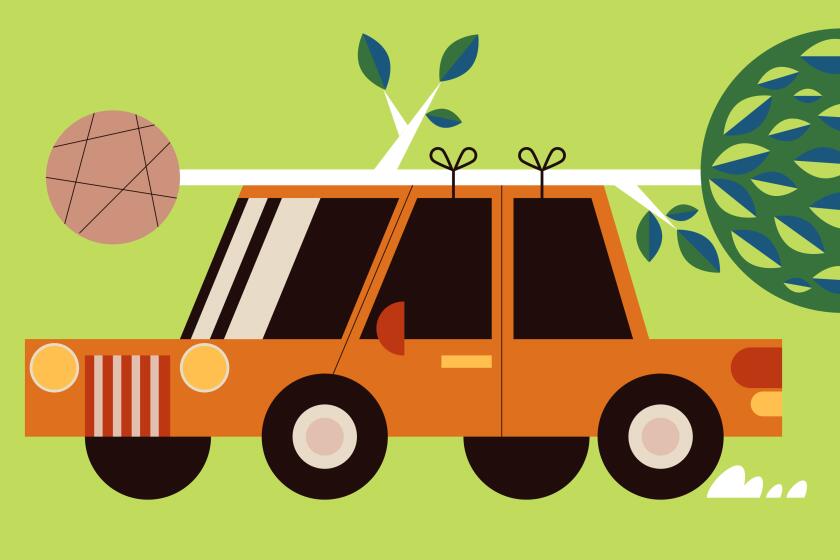Gardening : Fall Prime-Time for Planting on Hillsides
Landscaping a hillside can be a daunting project, so much so that Carole and Michael Dougherty lived in their Glendale home for 16 years before they tackled the steep hillside behind them. They learned to accept a previous owner’s makeshift retaining walls that were an eyesore but seemed to hold back the canyon wall.
Deeply involved in the historic preservation movement, the Doughertys met landscape architect Bob Perry when he designed the water-conservation demonstration garden at the historic Lummis Home in Highland Park. They soon caught the native plant bug and hired Perry to create drought-tolerant native plantings for their own hill.
The first steps were to return the hillside to its natural state by removing the old retaining structures and to install an irrigation system. The work was scheduled to have the slope ready for planting in the fall when native plants can get a good start on developing deep, drought-defying roots.
Hillside plantings need to be irrigated slowly to let the water sink in rather than run off. It sounds like a job for drip irrigation, but unfortunately drip is often unreliable on slopes where gophers and ground squirrels can chew up the flexible pipe used in drip systems.
For the Doughertys’ hill, the answer was an overhead watering system of Hunter gear-driven sprinklers that rotate silently, unlike the more familiar impact-type sprinklers. Each Hunter sprinkler comes with a set of 12 nozzles of different sizes. Landscape contractor Giancarlo Massarotto of West Covina used smaller nozzles (Nos. 3, 4, 5, 6) to give the slope a slow, deep watering without run-off problems. You can find Hunter sprinklers at a professional landscape supply such as J. H. Mitchell Co. in San Gabriel (818) 287-1101 or Modern Irrigation in Upland (714) 946-6951.
For those who don’t want to start over, Massarotto, an irrigation specialist, notes that you can retrofit an existing impact sprinkler system (Rainbird and Champion are major brands) to water more efficiently. The popular Rainbird 25 series comes installed with No. 10 nozzles, which put out from 3.5 to 5 gallons of water per minute depending on the water pressure. By changing to a No. 9 nozzle, available from a plumbing supply, you can cut down the flow by about 20%. A sprinkler that only rotates a half circle should have a smaller nozzle than one that covers a whole circle.
The next step was to cover the slope with jute netting to hold the soil in place. Available at landscape supply houses and some nurseries, “Soil Saver” jute netting comes in rolls four feet wide in an untreated brown version (about 60 cents a running foot) and a green type treated with a fire-retardant agent that costs a third more. You also need long wire staples to hold the jute in place, so it costs about $17 to $25 to cover 100 square feet.
By November, the hill was ready for the final step--planting. Small plants from flats and four-inch pots are easiest to plant through jute netting, but the mesh is loose enough that nursery stock from one-gallon cans can be planted without too much effort.
Because the jute lasts about two years before deteriorating, ground-cover plants like coyote bush and prostrate mountain lilac were spaced widely--they take longer to fill in that way, but they will be healthier and more drought-tolerant than plants spaced too closely. You can also sow seed of native wildflowers or other easy-to-naturalize flowers like sweet alyssum and toadflax among the newly planted shrubs for quicker cover and a show of color.
Jute netting is also valuable if you want to seed a slope instead of planting it, but another option in that case is to use soil erosion blankets made of straw and coconut fiber. These give the slope more protection than jute netting but they are too dense to plant through.
Instead, sow seed of grass, wildflowers or shrubs (wild buckwheat Eriogonum fasciculatum) is great for seeding on slopes), and then roll out the blanket and secure it with staples. A roll 6 1/2 feet wide and 83 1/2 feet long covers 60 square yards and costs from $55 to $80. Several types of soil erosion blankets are available from Drainage Products in Oceanside (800) 225-0797.
The Doughertys’ hill was planted in late fall with a medley of colorful and drought-tolerant native shrubs and perennials including sages, fremontias, penstemons, mountain lilacs, Matilija poppies and buckwheats. A tablespoon of Osmocote, a slow-release fertilizer, was mixed with the soil in the bottom of each planting hole. The hill was soaked with the sprinklers once a week until the big rains began in January.
Thanks to the jute netting, there was practically no erosion damage and the plantings rooted deeply and started to spread and bloom. During their first dry season in the ground, the new plants were soaked once a week with the sprinkler system. Next summer a soaking every three weeks should be plenty.
During the hillside renovation, California was up to all her usual tricks--a brush fire destroyed a neighbor’s home, deer nibbled new plants and years of stubborn drought were followed by torrential rains--but the garden’s careful planning and timely development paid off. In the spring the hill was bright with blue sage, red monkeyflowers and huge white Matilija poppies.
That’s California, too.






